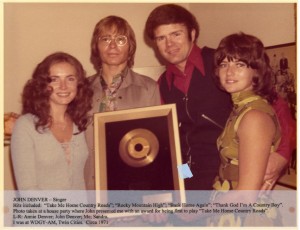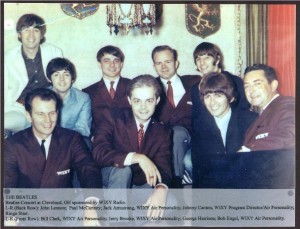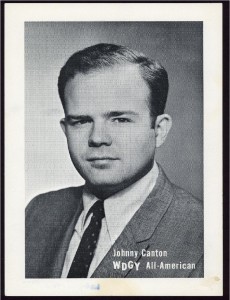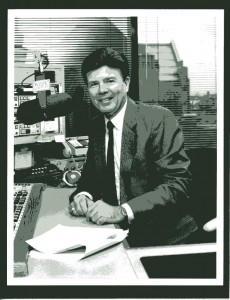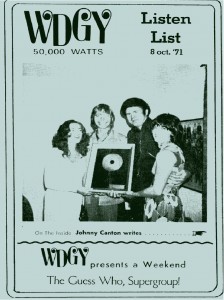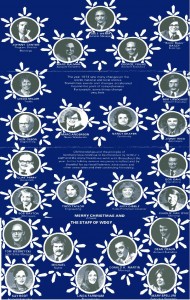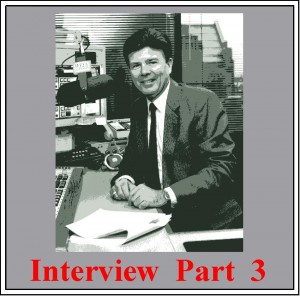Johnny Canton – WDGY Radio
One of the “All American” DJ’s at WDGY Radio
Contents:
History
Johnny Canton – WDGY Disc Jockey
Early Days
Johnny Canton was born in Kansas City, Kansas, grew up in the Kansas City area and seems to have been destined at a young age to have a career in the broadcasting business.
May 1958 – June 1959: KLEX AM (Lexington, Missouri)
At age 16 Johnny made his on air debut as a DJ on May 8, 1958. The first record he played on the show was “Yakety Yak” by The Coasters. Johnny was the host of a one hour Saturday afternoon show that featured rock’n’roll music (sponsored by a local record store), the only time slot for rock music amidst the radio station’s softer Hit Parade programming. Johnny worked the weekend shift at KLEX and worked Saturdays from 1:00 PM until sign-off and Sundays from Noon until sign-off.
June 1959 – August 1960: KOKO AM (Warrensburg, Missouri)
At KOKO, Johnny hosted a Saturday evening Top-40 show from 6:00 PM to 10:00 PM. The stations mainstays were The Four Freshmen, Peggy Lee, Perry Como and similar artists. Johnny was on the air weekdays from 7:00 AM until 12:30 PM, then went to classes at Central Missouri State College from 1:00 PM until 4:00 PM and then it was back to KOKO for a second shift from 4:30 PM to 6:00 PM. At college, Johnny took taking classes in theater, speech, and drama and also helped put the college radio station on the air.
August 1960 – March 1961: KZIX AM (Fort Collins, Colorado)
Johnny is once again at a new radio station, this time with no air time allotted for rock’n’roll music. The station played the Kingston Trio, Peggy Lee, Bobby Darin, and similar artists. Johnny became the news director and then program director, as well as being an on air personality.
March 1961 – August 1961: WNOW AM/FM (York, PA)
At WNOW Johnny gets his first job at a radio station with a Top-40 format and became program director as well as being an on air personality. .
August 1961 – September 1963: WRAW AM (Reading, Pennsylvania)
WRAW was a newly purchased radio station by Bill Rust (who also owned WNOW) and was in third place in the local radio stations when Johnny came to work for them as a DJ and as program director. Johnny switched the format to Top-40 with all on air personalities and in 90 days the station moved from third place to first place in the local ratings. In addition to his radio jobs, Johnny also wrote a music column for Berks County Record, wrote song lyrics for local bands (with one song published and released on the Swan record label), and co-owned a young adult club with an American Bandstand theme.
September 1963 – June 1964: KUDL AM/FM (Kansas City, Missouri)
Johnny worked at KUDL as an on air personality and also as program director. The station had a Top-40 format, but switched to classical music on November 23, 1963 following the assassination of President John Kennedy and returned to Top-40 after a number of days had gone by.
June 1964 – December 1965: WHAM AM (Rochester, New York)
After getting a call from station owner Bill Rust, whom Johnny had worked for in York and Reading, Pennsylvania, Johnny took over the late afternoon slot from 3:00 PM to 6:00 PM. The station did not have a Top-40 format. It was a 50,000 watt clear channel flagship station. While working at WHAM, Johnny was asked by Xerox Corporation to narrate a CBS TV special called “The Making of the President” for David Wolper.
December 1965 – October 1966: WIXY AM (Cleveland, Ohio)
At WIXY, a stations with a Top-40 format, Johnny was an on air personality and also became program director. During the height of Beatlemania the station was playing one song by The Beatles for every three songs played. On August 14, 1966, Johnny added his name to a very small and very elite group of people who had the once in a lifetime opportunity to introduce The Beatles at one of their concerts in the United States. The show was held at the Cleveland Stadium and including opening acts: The Remains; The Cyrkle; The Ronettes; and Bobby Hebb. A local businessman provided a custom made mobile home that was set up right behind the stage near second base as a “holding room” for The Beatles. In the mobile home, Johnny got to visit with The Beatles and their manager, Brian Epstein, prior to the concert.
While working at WIXY, Johnny received a phone call George “Bud” Armstrong, Executive Vice President of Broadcasting for Storz Broadcasting out of Omaha, Nebraska. George Armstrong was aware of Johnny Canton and knew he wanted to work at a Storz owned radio station. George advised Johnny to contact WDGY Radio in Minneapolis where there was going to be an opening. Johnny called WDGY and talked to Phil Trammel, the GM, and also Scott Burton, the program director and also one of the DJ’s. Johnny was offered a job over the phone and accepted the offer. After a telegram was sent to confirm the offer, Johnny departed Cleveland, Ohio and relocated to Minnesota.
November 1966 – March 1977: WDGY AM (Minneapolis – St. Paul, Minnesota)
Johnny started out as music director and on air personality and took over the Noon to 3:00 PM afternoon shift (formerly occupied by Johnny Dollar) at WDGY, also known as WeeGee on the radio dial at 1130 AM. When Johnny started at WDGY the DJ’s were:
George Young: Midnight to 6:00 AM.
B. Mason Dean: 6:00 AM to 9:00 AM.
Perry St. John: 9:00 AM to Noon.
Johnny Canton: Noon to 3:00 PM.
Scott Burton: 3:00 PM to 7:00 PM.
Jim Dandy: 7:00 PM to Midnight.
WDGY had nine broadcast towers just West of Freeway 35W between 102nd Street and 106th Street, with 50,000 watts of power and broadcast 24 hours a day, 7 days a week. The format was Top-40. The station was first started by Dr. George Young. WDGY could draw up to 325,000 listeners in one hour and were in a constant battle with rival Top-40 station KDWB (630 on the AM dial) for the number two spot in local radio. WCCO (830 on the AM dial) was the number one station in the Twin Cities with a non-Top-40 format. When Scott Burton left WDGY, Johnny took on the job as program director.
In 1968, Johnny received a Radio-TV Mirror Magazine Award for radio Personality of the month.
Johnny Canton, along with other DJ’s at the station supported the local rock bands, a tradition that went back to DJ Bill Diehl during his tenure at the station. Johnny played the records of the local bands on the air and worked as an emcee at local band jobs including shows at the St. Paul Winter Carnival, the PromCenter, the Bel Rae Ballroom, and numerous other venues including events for the Minneapolis Aquatennial.
In addition to working with the local bands, Johnny also brought in national talent and emceed their shows. Among the national acts that Johnny brought to the Twin Cities were Aretha Franklin, Tiny Tim, Dionne Warwick, Paul Revere and the Raiders, Sonny Bono, and for Christmas shows, Andy Williams and Roger Miller.
WDGY ran a variety on air listener contests. The “Fortune Phone” contest involved dialing local phone numbers obtained at random from the phone book and asking whoever answered the phone if they could name the current amount of the cash prize which started at $113.00 and then increased with every wrong answer. This was done live on the air with no time delay with Johnny and the other DJ’s only having access to a kill switch in the event of something going wrong.
Another contest was the “Mystery Song of the Day” which involved a DJ announcing the name of the song which would be played at some point during that day and then listeners would call up the station if they knew the song and heard it played.
Yet, another contest was the Tongue Twister Contest where listeners would mail in a “tongue twister” for the DJ, who had to repeat the tongue twister six times in a row without making any mistakes. If the DJ failed, the listener who submitted the tongue twister was mailed a check for $1.13 from Storz Broadcasting Company.
A promotion known as “The Hit Man” involved Sales Manager Mark Kalman (or one of station interns) driving around town in a painted car and dressed up as a “hit man” stopping people on the street and asking them to name their favorite radio station. If the person replied “WDGY” they would get to go live on the air via the phone and would win a “Hit Man” t-shirt and other prizes.
In the summer of 1967, WDGY began to promote a concert with headliners Sonny and Cher scheduled for July 14, 1967 at the Minneapolis Convention Hall. Sonny and Cher were at the peak of their career with a long string of hit records and a hit national TV show. Shortly before the concert Sonny contacted Johnny and told him the duo could not appear due to a health issue with Cher. Johnny asked Sonny to perform solo but Sonny declined numerous times. With the show still set to go on, Johnny came up with a plan: WDGY would audition local female singers to fill in for Cher. From a group of 25 hopeful contestants, 12 were picked for the show, each one would sing a different song with Sonny. Sonny agreed to the plan at the last minute and the show went on with 12 local female singers getting their chance to sing with Sonny Bono and to be “Cher” for one night… for one song. Sonny, using his unique sense of humor, made the event a success. This is reported to be the only show where Sonny Bono appeared live without Cher. Local bands The Del Counts and The Stillroven opened up the show.
In 1969, Johnny was selected to play a minor role of a ticket agent in the Ross Hunter/Universal Film “Airport” which was partially filmed in Minneapolis.
On June 6, 1969, WDGY hosted a concert at the Minneapolis Auditorium with Gary Puckett and the Union Gap, The Peppermint Rainbow, and The Corporation. The concert was billed with the band names and the “WDGY All Americans”: Johnny Canton; Jerry Brooke; Scott Burton; Gene Leader; and Jim Dandy.
In early 1970, Johnny was invited by Bill Carlson and Nancy Nelson to attend a Kris Kristofferson concert in town. Johnny went to the concert and discovered that Bill and Nancy had also invited John Denver and his wife Annie to the show. Johnny knew that John Denver had been a member of the folk group the Chad Mitchell trio (from 1965 to 1967) and that he had written “Leaving on a Jet Plane” which was a number 1 hit song for the folk trio Peter, Paul and Mary in late 1969 (their biggest and last hit song). John Denver informed Johnny Canton that he was about to release his first album as a solo artist on RCA Records (“Poems, Prayers and Promises”) and asked for some feedback regarding his idea that a cut on the album called “Take Me Home, County Roads” just might be released as the single from the album. When the album came out, Johnny played the song off the album and contacted other Storz radio stations to encourage them to give the song a spin: WTIX in New Orleans; WQAM in Miami; WHB in Kansas City; KXOK in St. Louis, Missouri; and KOMA in Oklahoma City. In addition, Johnny also had John Denver on the air for an interview. The song was released as a 45 on April 12, 1971 and did not do well for many weeks and RCA was close to giving up on the record (John Denver encouraged them to keep promoting it). Finally, the record took off and “Take Me Home, Country Roads” became a national hit, reaching Number 2 on the Billboard Hot 100 and certified as a Gold Record (one million copies sold) on August 18, 1971. John Denver had a hit song and a new solo career as a singer/songwriter. John Denver gave Johnny Canton credit for helping launch his solo career in his 1994 Autobiography “Take Me Home” written by Denver with Arthur Tobia.
In April, 1970, Danny Stevens of Danny’s Reasons introduced Johnny to Alan Fingerhut. Danny and Alan were co-owners of a new downtown nightclub called The Depot, formerly a Greyhound Bus Station. Johnny was invited to emcee the two night grand opening of the club on April 3 and April 4 which featured Joe Cocker’s “Mad Dogs and Englishmen” national touring show (20 musicians on stage under the musical direction of Leon Russell). The show brought thousands of music fans to The Depot and Johnny was filmed that night and can be seen on a documentary film (“Mad Dogs and Englishmen”) of the tour.
During his years at WDGY, Johnny interviewed many famous musicians, in person and over the “Hit Line” including: Andy Williams, Ringo Starr, John Lennon, Helen Reddy, Tony Orlando, Frankie Valli, Neil Sedaka, and Bette Midler.
In early 1977, WDGY hired a new program director and General Manager Dale Weber decided to switch the Top-40 format to country music. In December of 1977 the Top-40 format came to an end and all of the employees were let go. Johnny was offered a job as Executive Vice President for Metropolitan Advertising which worked in print and broadcasting. This job led to the formation of Canton Communications, Inc. in 1978, an ad agency and radio-TV production firm, still operating in the Twin Cities.
December 1977 – June 1984: WCCO FM (Minneapolis – St. Paul, Minnesota)
Johnny worked for WCCO FM which changed their call letters to WLTE-FM in January, 1984.
September 1985 – December 2011: WLTE FM (Minneapolis – St. Paul, MN)
In the fall of 1985, Johnny retuned to work at WLTE-FM, a station that featured an easy listening format, also known as “light rock.” In December, 2011, the station changed its format to country music and eliminated all WLTE-FM on air personalities.
When local TC sportscaster Tom Ryther resigned from his job as host of the television show “Bowling for Dollars” Johnny spoke with Ron Magers at Channel 5 and was offered the job, which he accepted. Johnny hosted “Bowling for Dollars” from November, 1977 through August, 1978. Later on, Johnny hosted “Bowlerama” on KMSP-TV (Channel 9) from 1983 through 1987.
UPDATE:
On October 28, 2006, Johnny Canton was inducted into the Minnesota Broadcasting Hall of Fame, a tribute to his 53-plus years of continuous broadcasting.
On November 11, 2013, during an interview with Tom Campbell, Johnny recalled his days with WDGY: “It was a fun radio station and we had a good time. It was a very popular radio station.”
Photos (Click a photo to see it full-screen, then click the arrows to see the next one.)
Where are they now
Johnny Canton passed away at age 75 on December 31, 2016. He was living in Minnesota at the time of his passing.
Interview
Interview PART ONE – Time = 25:58
Interview PART TWO – Time = 29:10
Interview PART THREE – Time =27:08



